Puget Systems Serenity SPCR Edition: Blissful Silence
by Dustin Sklavos on February 10, 2011 12:00 AM EST- Posted in
- Systems
- Intel
- Radeon
- Sandy Bridge
- Puget Systems
- Serenity SPCR
Application and Futuremark Performance
At this point it goes without saying that Sandy Bridge is fast, but this time around we have a stock-clocked system contending with both an overclocked Sandy Bridge unit and quite a few systems featuring some overclocked representatives of last generation's finest. While you're looking at these benchmarks, though, try to remember that Puget Systems tuned the Serenity SPCR Edition for maximum silence. The Intel Core i5-2500K hasn't been touched, and the PowerColor Radeon HD 5750 included is tied for the fastest passively-cooled video card on the market. You can hear all of the other systems here under load, but you can't hear the Serenity.
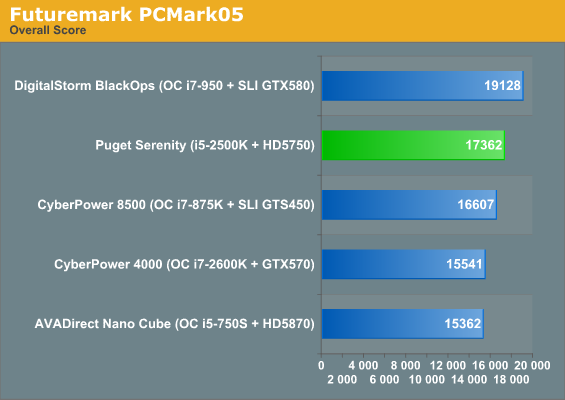
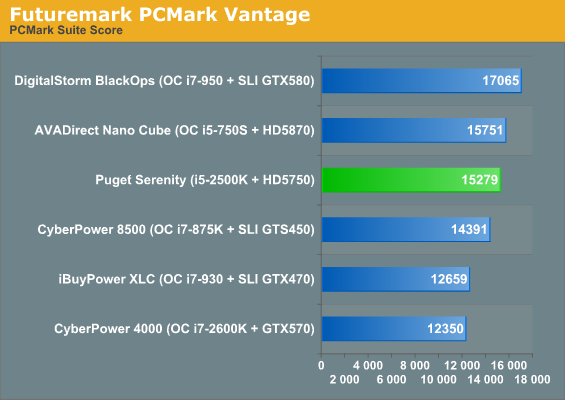
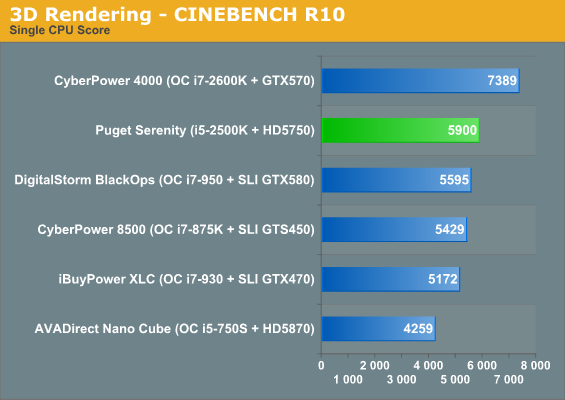
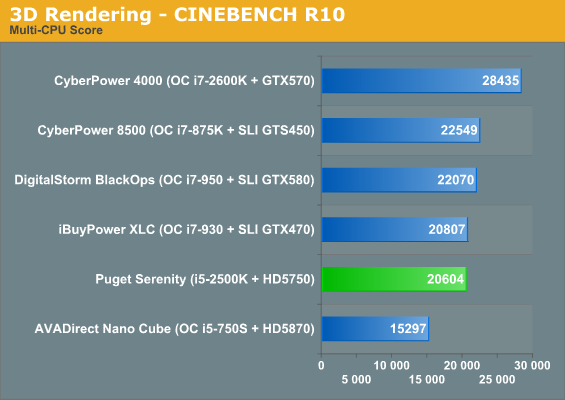
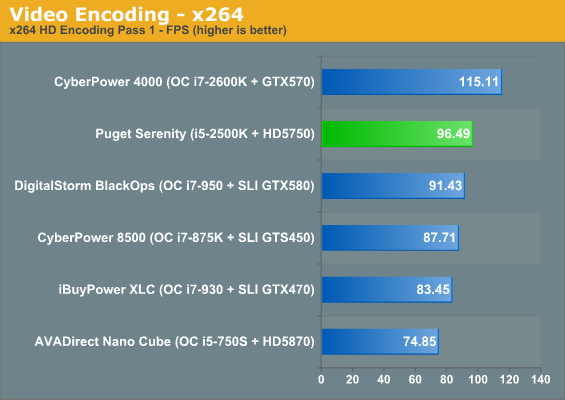

As you can see, even at stock clocks with no Hyper-Threading, it still takes a lot to hold Sandy Bridge down. The DigitalStorm and CyberPower 8500 systems are both running their processors at 3.8GHz, and DigitalStorm's tower has the added benefit of triple-channel memory. In fact the only chips that aren't Hyper-Threaded are the i5-2500K and the i5-750S, and while the i5-750S basically trails the competition here, the i5-2500K's worst showings still mostly nip at the heels of the 3.5GHz processor inside the iBuyPower XLC.
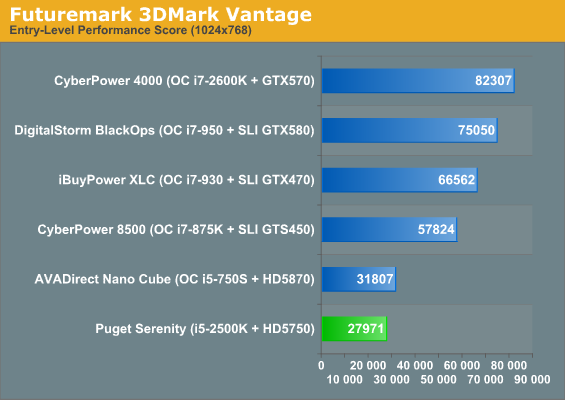
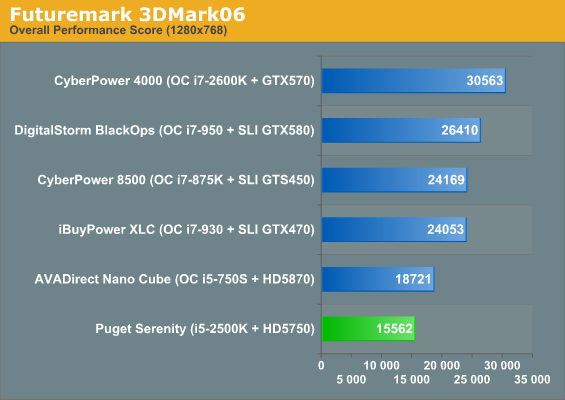

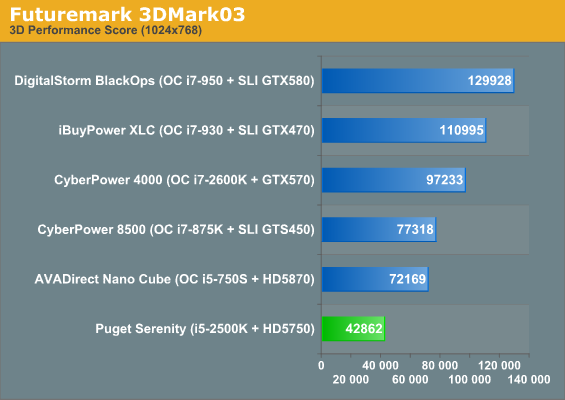
3DMark is less kind to the Puget Systems Serenity, but it still posts a strong showing and as we'll see the 5750 at its heart is for the most part able to game at 1080p. Again, remember that the Serenity is basically inaudible during gaming sessions and power consumption is remarkably low, as you'll see later. Of course, if the 5750 just doesn't cut it for you it's worth repeating that Puget Systems is working on getting a passively-cooled Radeon HD 6850 in house. It's entirely possible that by the time they can start shipping Sandy Bridge-based systems like this one again you'll actually be able to make that upgrade.










139 Comments
View All Comments
pcfxer - Thursday, February 10, 2011 - link
RTA analysis + anechoic chamber time = engineering.They hand picked the fans, coolers, etc. to work together based on what they believed to be appropriate compromises.
Let's take your simpleton description to another analogy.
"Engineering? They took some bolts, some plastic, motor oil, a few sensors to fit inside a mustang body! Damn them and their highly efficient 5.0L with more horsepower than a base Corvette!"
Like I said, some of you just don't get what Engineering is.
FunBunny2 - Thursday, February 10, 2011 - link
Don't be so quick to jump on that bandwagon. OCZ has been getting a lot of heat over its Vertex 2 parts built with 25nm NAND. A topic you should pursue, by the way.bigbob123456 - Thursday, February 10, 2011 - link
Speaking from experience, I can tell you that's the most half-assed foam installation. First that's a cheap medium density foam. Quality would mean using 1/4" neoprene, which costs 3x as much as what they used. Second, they're making a mistake in cutting slots in the foam for the structure of the case...it's FOAM it'll compress to compensate. Third, they could have used 3x as much foam as they did. I see lots of exposed metal at the back of the case, around the motherboard, on the drive cage, etc.I recently bought some foam and did my own installation, and every square inch you cover beyond just the front / sides does make an audible difference. In a lot of places I even doubled up on the foam.
HangFire - Thursday, February 10, 2011 - link
"I recently bought some foam and did my own installation, and every square inch you cover beyond just the front / sides does make an audible difference."Wow, impressive. So how much lower than 11db did you get? And how is it you could actually hear the difference below 11db? Are you an Owl?
Or maybe... once PS got to 11db... they knew they could stop right there?
bigbob123456 - Thursday, February 10, 2011 - link
Obviously I did my own installation in a normal game box, subjectively cutting the noise level in half. The point is it speaks to the level of overpricing on this machine given the quality (lack of) they put into it. For example, if they would have done some better foaming they probably could have thrown in a 6870 or something instead of a useless 5750 and had the same results. Duh.HangFire - Tuesday, February 15, 2011 - link
Puget Sound does make gaming systems. Anandtech didn't review of them them. D'oh.MeanBruce - Thursday, February 10, 2011 - link
I guess you can purchase a PC like this one and let someone else decide and define a silent PC for you. But for $2200 you can build a much quieter and much higher performing and much better looking PC than this Puget. Corsair AX850 is a much better psu than this Antec, Noctua NH-D14 is a much better CPU cooler than the Gelid, and the Asus 6870 direct cu is a much better video choice than the 5770. Do some research put some time into it learn a great deal and pay yourself in better components instead of paying Pugit for assembly costs!Wrap all these great parts in a Corsair Obsidian 650D enclosure and run the 6870 fan on auto. It's 10decibels of hardware heaven! Enclose your hardware not your mind!
PartEleven - Thursday, February 10, 2011 - link
I think you have no idea how quiet 10 db really is. The system you described is no where near 10 db.kevith - Thursday, February 10, 2011 - link
You're absolutely right: 10 dB is VERY little sound.MeanBruce - Thursday, February 10, 2011 - link
Oh I know 10db and 8db and 6db. Read my earlier comments on each component, this article. Maybe you are not up on the latest heatsinks by Asus they are huge allowing fans to run at idle 15 percent and stay in the 30s. I know the fan can also produce 30db but I am talking idle and working in Office apps, not gonna argue but the AX850 is dead silent fan does not move under 25percent load and the Noctua NH-D14 I run with no fans passive! Don't assume until you really know!